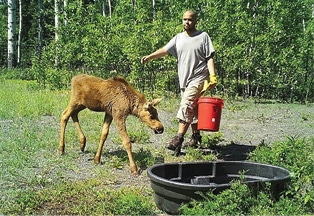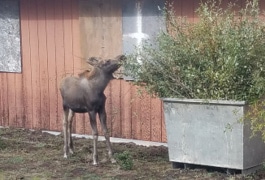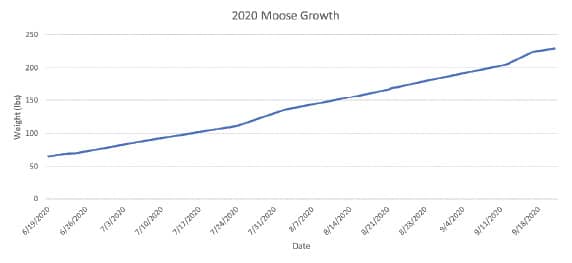By Dustin Carl, Wildlife Biologist, Ahtna Intertribal Resource Commission

Ahtna Intertribal Resource Commission (AITRC) was contacted by the Alaska Department of Fish and Game (ADF&G) to participate in their Orphaned Moose Program. AITRC’s team of wildlife biologists, interns, and dedicated volunteers took on the responsibility to rehabilitate and release orphaned moose calves back into the wild. We received one orphaned moose calf from Homer, Alaska on June 18, 2020. The calf was raised according to ADF&G protocols.
When AITRC received the moose calf, she was estimated to be 4-6 weeks old and weighed 64 pounds (29 kg). The moose calf was first placed in a small 10’ X 20’ pen with bundles of willow and a container of water to monitor her health and behavior before being allowed to roam around in the larger pen. Stocks of willow browse were collected and delivered to the inside of the pen twice per day. Willow collection increased throughout the season from armfuls to truckloads. The calf preferred browsing on the vegetation growing in the pen before settling on the browse delivered to her. Daily activity logs were kept on browse collection, watering, pen cleanings and weekly weight measurements.

The moose calf consistently gained weight throughout the summer and reached a weight of 229 pounds (104 kg). The calf was given an extensive workup by trained veterinary personnel to ensure she was healthy and free of any disease. She was then equipped with a VHF transmitter ear tag and released at one of the Ahtna, Inc. moose browse enhancement sites on September 22, 2020.
Radio tracking will occur throughout the winter to monitor range, habitat selection, and survival.
This program is a great opportunity for tribal citizens, shareholders, and local residents to gain insight into careers within natural resource and wildlife management. The payoff for everyone involved was watching the moose calf walk off into the forest to start her life in the wild.

Future plans include building a larger facility with bigger pens to accommodate more moose and an area to transition calves using a soft release system. The facility will allow calves to browse naturally without human interaction, better preparing them for release into the wild. In addition, the facility will increase the amount of moose released into local populations that will supplement subsistence hunting.
